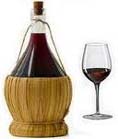Coffee Makers - 2
from Italian Traditional Food
More about coffee makers
Check out these great Italian ideas at Amazon for Italian food and kitchen ideas.
<<
Previous Page
2
Continuing the short article on coffee makers
Vacuum
Vacuum coffee makers consists of two glass bowls with a centre funnel. Coffee
is put in the top bowl, cold water in the lower one, and the machine put on the heat. When the water boils the top
bowl containing the coffee is inserted into the lower one and the water rises through the funnel into the top bowl,
leaving a little water in the lower bowl to ensure it won't crack.
The water and coffee should be stirred, then left on a low heat for a few minutes, while the
made coffee filters back into the lower bowl. Vacuum types need more attention than other coffee makers, but there are table models, making this less of a disadvantage. Many connoisseur
swear by vacuum coffee makers, despite the extra work. It is easy to keep coffee hot in
these machines, which are also handy for making large quantities. The glass is easy to keep clean - also east to
break - but separate parts can be replaced.
It is not possible to make smaller amounts of coffee in a machine designed for much larger
quantities, eg. 2 cups in a 8 cup machine, because the bottom container would not have sufficient water in it for
the process to work; but one can vary the quantities to a lesser extent.
Table models come with a spirit lamp heat or an electric heating element in sizes from 2 - 10
cup capacity.
Percolators
Percolators comprise a jug and a basket (for the coffee), to which a tube is attached so that
the water can pump through the coffee. When the water reaches the right temperature (usually at just below boiling
point in an electric, automatic type) it rises through the tube and washes through the coffee. This process is
repeated a number of times.
With non-automatic percolators you should watch for the coffee to reach the right strength and
colour. With some automatic percolators it is possible to set the controls to make coffee of different strengths;
with others this process is automatic. Both kinds of percolators need little attention and clean easily.
When cleaning automatic ones, take care that electrical parts are not immersed in water.
Many coffee connoisseurs do not like percolated coffee, considering that the water percolates
through the grounds too many times and produces a thin, stewed and often bitter flavour. However, percolators are
very popular.
There are no problems about keeping coffee warm in a percolator; the non-automatics can be left
on the heat, and most automatics can be set at a low, warming heat once the coffee is made, while some are fitted
with thermostats which ensure that the coffee won't become too hot and start to boil.
There are now many makes of percolator on the market, usually in 6 or 8 cup sizes. Automatics
are available in modern and traditional designs, ceramic or stainless steel. The non-automatics are usually of
aluminium, sometimes with a chrome finish, but ones in stainless steel or a flameproof ceramic glass are also
available. It would appear that when it comes to coffee makers, the choice is yours!
Page 1 of this article can be found on the previous page.
<<
Previous Page
2
Read more Italian traditional food
related articles here

Copyright © 2009 -
. All Rights Reserved Worldwide. Italian Traditional Food
You may not reprint articles from this website
without the written permission of the site owner.
Disclaimer: Articles on this
Website are provided for information purposes only. Italiantraditionalfood.com does not accept any responsibility
or liability for the use or misuse of the article content on this site or reliance by any person on the site's
contents.
| 


 Digg
Digg Stumbleupon
Stumbleupon Google Bookmarks
Google Bookmarks Delicious
Delicious Twitter
Twitter Facebook
Facebook Yahoo My Web
Yahoo My Web Reddit
Reddit